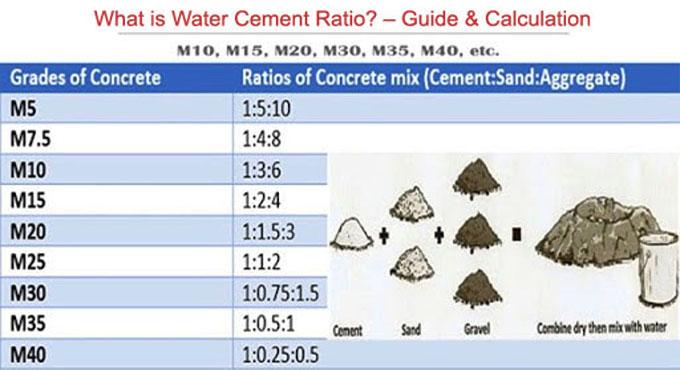
The Water-Cement Ratio in Concrete
Water cement ratio of concrete can be characterized as the ratio of the volume of water to the volume of cement utilized in a concrete mix. Water has an extraordinary function in the strength and functionality of concrete. After loads of investigations it has been discovered that for a particular extent of materials in a concrete mix, there is a sure measure of water that invigorates greatest.
The most significant factor deciding the strength of concrete is the water to cement ratio. It is the ratio of weight of mixing water (free water accessible for the response with cement) to that of cement in the mixture. Cement needs water of about 38% by weight for complete hydration. However, since the total hydration is a drawn-out cycle, and under useful conditions, the time of concrete mixing and projecting being short, the cement joins with just 23% of water.
On the off chance that solitary 23% of water is included while mixing, the concrete won't be serviceable in light of the fact that the water-cement ratio of 0.23 will be excessively less. So extra water will be required for functionality.
This water in overabundance of 23% by weight will dissipate on drying of concrete, making voids in it because of catching of air bubbles internal parts, subsequently decreasing the strength of concrete.
Expecting full compaction, and at a given age and ordinary temperature, strength of concrete can be taken to be conversely corresponding to the water-cement ratio. This is supposed the Abrams' law.
Water Cement Ratio Formula:
Water Cement Ratio Formula is utilized to ascertain Strength of concrete.
S = K(c/(c+w+a))2
where,
S = strength of concrete
K = a constant
c, w and a = volume of cement, water and air separately
Degree of Hydration: y and large, strength of concrete is communicated as a component of water-cement ratio. However, strength at any water-cement ratio relies on the "degree of hydration" of cement.
Strength of the concrete is reliant on strong results of hydration of cement to the space accessible for arrangement of this item: "gel/space ratio". The customary connection among strength and water-cement ratio will hold great fundamentally for 28 days strength for completely compacted concrete.
Rather than relating the strength to water-cement ratio, the strength can be all the more accurately identified with the strong results of hydration of cement to the space accessible for the arrangement of this item. This ratio is characterized as the ratio of the volume of the hydrated cement glue to the whole of volumes of the hydrated cement and of the slim pores.
Aggregate to Cement ratio: The aggregate-cement ratio speaks to the volume of cement glue in a concrete for a given water-cement ratio.
Higher the aggregate-cement ratio, lesser will be the volume of cement glue and the other way around. Higher aggregate-cement ratio implies, bigger volume of concrete is involved by the aggregates subsequently less extent of cement glue.
The full volume of porosity in concrete framed after the hydration would be lower for the lower volume of cement glue utilized. In the event that the absolute volume of porosity is lower, at that point the strength of concrete will be higher.
It has been discovered that for a constant given water-cement ratio, a less fatty mix prompts a higher strength. A slight change in the measure of water causes considerably more contrasts in the strength of concrete. In the event that less water is utilized, the resultant concrete will be almost dry, hard to put in the structure and may make troubles in compaction. Other than this, with less water, the correct setting won't be ensured and accordingly the strength of concrete get decreased extensively.


